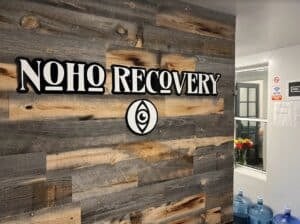Lean Detox And Withdrawal
What Is Lean?
Also known as Purple Drank, Sizzurp, and several other names, lean is a liquid concoction of Codeine, cough medicine containing either the antihistamine Promethazine or Dextromethorphan (DXM), a carbonated beverage, hard candy, and occasionally alcohol. Independently, Codeine and Promethazine are both depressants that largely affect the nervous system, and when they’re combined, the result is intense and euphoric sedation. In larger quantities, lean has been found to induce hallucinations and lucid dreams or nightmares; some artists have claimed it to assist in their creative process. Potentially deadly, this dangerous cocktail can cause numerous other effects in the body such as dizziness, loss of consciousness, seizures, severe constipation, and sometimes death.
Online Addiction Counseling
Get professional help from an online addiction and mental health counselor from BetterHelp.
- Access to Therapy 24/7
- Easy Online Scheduling
- 20,000+ Licensed Therapists
Paid Advertising. We may receive advertising fees if you follow links to the BetterHelp site.
Effects Of A Lean Withdrawal
Some of the broader symptoms of withdrawal include:
- Agitation
- Loss of appetite
- Runny nose
- Teary eyes
- Body aches
- Yawning
- Trouble sleeping
- Diarrhea
Codeine
The main ingredient of lean is Codeine and as such, the causes and symptoms of withdrawal are in line with those of other Opioids. Because of their numbing effect on the mind and body, Opioids are incredibly addictive and can cause significant damage. Though Codeine is considered to be one of the weaker prescribed pain medications (in comparison to that of Morphine or Fentanyl), it is just as likely that excessive or illicit use can lead to a tolerance.
When the body is no longer receiving a substance it has become dependent on, it goes into withdrawal. In the short-term, an individual may feel anxious, irritable, restless, and have a hard time sleeping. The long-term effects are more detrimental: permanent psychosis, the formation of brain lesions that cause memory loss, changes in behavior, and cognitive deterioration.
Promethazine
Commonly found in allergy medications, Promethazine works by blocking allergy-response chemicals in the brain. This causes a sedative effect which is why it is so popularly combined with Codeine in lean; the combination intensifies the high and feelings of tranquility. The drug has also been found to combat Opioid-induced nausea and is even used to aide in alleviating withdrawal symptoms.
Because the consumption of this compound is largely coupled with Opioids and the sale is legal, there is limited research on the symptoms of Promethazine; only overdose and withdrawal. Some of the few common signs of a Promethazine overdose are similar to its potential side effects like loss of coordination, severe drowsiness, irregular breathing, and seizures.
Dextromethorphan (DXM)
A cough suppressant, DXM communicates with the part of the brain that triggers coughing. Used as a replacement for Codeine in cough/cold medicines, this substance can imitate illicit drugs like Ketamine or Ecstasy if consumed in high doses. When taken as directed, there are minimal side effects apart from the occasional fatigue, nausea, or vomiting. If enough of the substance is consumed to lead to a dependance, withdrawal symptoms can present in the form of disturbed sleeping patterns, nausea, and excessive sweating.
How Long Does Lean Stay In The Body?
| Length Of Time Lean Is Detected In Samples | |
|---|---|
| Saliva | 1-4 days |
| Blood | Up to 24 hours |
| Urine | 2-3 days |
| Hair | 2-3 months (following 2-3 weeks after consumption) |
Looking for a place to start?
Join the thousands of people that have called a treatment provider for rehab information.
Free and confidential
Available 24/7
Access to professional treatment
Detoxing From Lean
Though the individual elements of lean are legal, that doesn’t make the drink (or the misuse of any of the constituent components) without significant consequences. Of all the substances present in the cocktail, Codeine is the most problematic and habit-forming, making detox imperative for anyone experiencing a lean addiction. While lean withdrawal is not necessarily life-threatening, the detoxification process presents uncomfortable challenges that many individuals suffering from addiction choose to avoid by continuing to use despite the associated risks.
These challenges are made harder when one attempts to treat themselves and detox at home without the presence and assistance of a medical professional. At a medical rehabilitation facility, doctors are there throughout the process, prescribing medications and ensuring that treatment plans are catered to the individual and their unique needs. Without medical supervision, one does not have the access to certain medications like Clonidine or Librium which help to alleviate the intensity of withdrawal symptoms. Buprenorphine may be given to shorten the amount of time spent detoxing and Methadone can ease the pain felt during the detoxification period.
One of the other common medications used to assist in Opioid withdrawal management is that of Naltrexone or Naloxone. The first is used in prolonged treatment of an Opioid use disorder as well as that of alcohol, rendering it especially useful in cases where lean has been laced with alcohol in addition to the “normal” ingredients. Naloxone is an emergency medication that rapidly reverses an overdose by binding to Opioid receptors and blocking/reversing the effects of incoming Opioids.
Attending a rehabilitation center provides a safe and stable environment in which professionals are present every step of the way toward eventual sobriety; reach out to a treatment provider to ask questions and learn more.
Get Help Today
If you or someone you know and love is struggling with lean addiction or abuse, it’s important to remember that there are resources to help you. Contact a treatment provider to learn more about recovery and treatment options.
Check if my insurance covers rehab
Addiction Center is not affiliated with any insurance.
Published:
Author
Hannah Zwemer

-
Hannah Zwemer graduated with a BA in dance and a minor in educational studies from Denison University in 2017 before moving to Orlando to work as a performer at Walt Disney World. While at Disney, she discovered her passion for writing and pursued a master’s degree in creative writing with an emphasis in nonfiction. She is passionate about helping people in any way she can while simultaneously sharing stories that remind us that the best of us are still only human.
- More from Hannah Zwemer
Reviewed by Certified Addiction Professional:
David Hampton

A survivor of addiction himself, David Hampton is a Certified Professional Recovery Coach (CPRC) and a member of the National Association of Alcohol and Drug Abuse Counselors (NAADAC).
- More from David Hampton
Sources


Recovery Starts Today
Call Now For Addiction Support



Newport Academy – Teen Rehab Center
Port Townsend , WA


Sequoia Detox Centers
Spokane Valley , WA


Moonlight Mountain Recovery – Nampa
Nampa , ID

Bayside Marin Treatment Center
San Rafael , CA

Newport Institute for Young Adults
Sunol , CA

The Camp Recovery Center
Scotts Valley , CA

Moonlight Mountain Recovery
Pocatello , ID


Tarzana Recovery Center – TRC
Tarzana , CA



Hollywood Hills Recovery
Los Angelos , CA